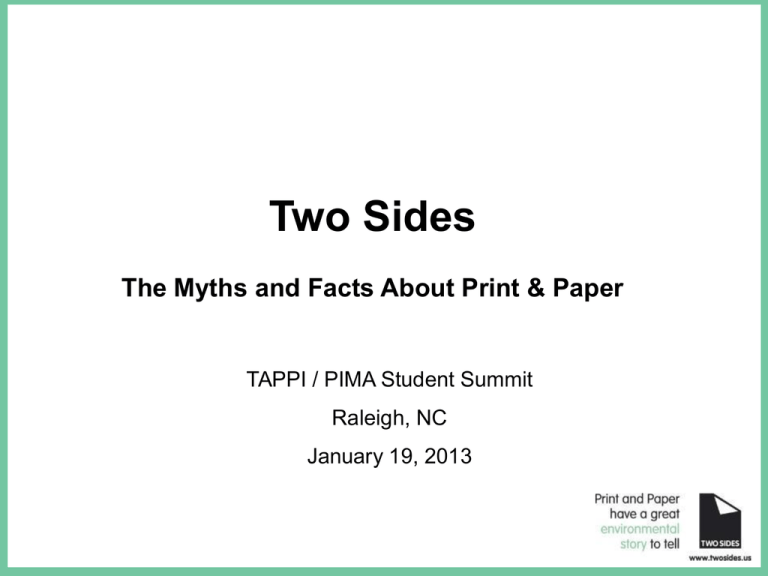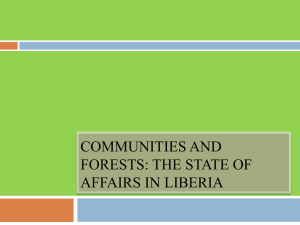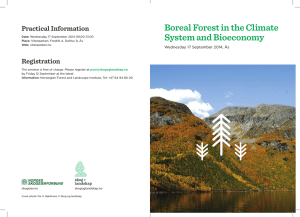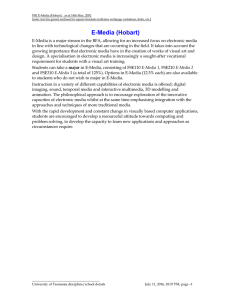Two Sides - Myth and Facts about Print & Paper
advertisement

Two Sides The Myths and Facts About Print & Paper TAPPI / PIMA Student Summit Raleigh, NC January 19, 2013 Print Power Presentation to Canon, 4th February, 2010 What is Two Sides? • An initiative by companies from the Graphic Communications Value Chain, with now over 1,000 members. • Non-profit launched in 2008 in the UK and present in 3 continents and over 12 countries. • Two Sides U.S., Inc. began operating in January 2012. Print Power Presentation to Canon, 4th February, 2010 Print Power Presentation to Canon, 4th February, 2010 Our Mission 1. Promote the responsible production and use of print and paper. • Reduce impacts over the life cycle • Sustainable forest management / certification • Environmental performance at manufacturing • • • • facilities (emissions to air, water, solid waste) Renewable energy at facilities / grid Best practices for responsible paper use (ex: promote paper recovery) Responsible procurement Reduce carbon & water footprint • Several tools, guidance documents and paper scorecards available at www.twosides.us 2. Dispel common environmental misconceptions Two Sides sends open letter to Mr. Eric Schmidt, Chairman and CEO of Google in response to the newly announced ‘Go Paperless in 2013’ campaign 3. Provide verifiable information on why print and paper can be a sustainable way to communicate • www.twosides.us is a repository of science-based information and news • • • • Reports, articles, facts, videos Tools Upcoming events Searchable database by topic • Customizable brochure on the Myths & Facts of Print and Paper • Print advertising • Conferences, webinars Myths and Facts - www.twosides.us Supporting website - www.youlovepaper.info/US Print Power Presentation to Canon, 4th February, 2010 Print Power Presentation to Canon, 4th February, 2010 Business focussed magazines Over 70 US Organizations Have Joined Two Sides • Commercial Members • Allied organizations Why Two Sides? • Need to promote the sustainable features of paper and print • Negative and misleading news often prevails re: environmental impacts of paper • Lack of a strong and common forest products industry voice Results of 10-country Consumer Environmental Perception Survey (2010) • Paper is the preferred information medium for reading and storage of documents – all ages, incl. 18-24 year olds • ~70% of respondents, • Paper not seen as environmentally preferable way to read. • • 70% link paper to tropical deforestation & concerns about forests Actual: US forest area has remained stable for the past 100 years, and growing volume has increased by 49% (USDA, 2010) • ~80% of 18-24 yr.o. chose electronic as the most environmentally-friendly way • Books 56%, Newspapers 64% For a summary of survey results click here Two Sides Messaging Framework Print and paper has a sustainable life cycle from raw material to recovery and reuse • • • • Print and paper have unique sustainability (environmental, social) features Responsible use of resources is key Industry environmental performance is continuously improving Promote responsible use of print and paper over the life cycle (purchasing / best practices) Based on a renewable resource A great carbon story • • • • • • • Sustainable forest management Forest certification Biodiversity Ecosystem services Benefits of a working forest • Minimizing carbon footprint Use of renewable energy and carbon neutral biomass Carbon benefits of managed forests and forest products Recyclable Effective communications medium • • • • • Increased recycling Eventual elimination of print and paper waste in landfills Smart use of recycled fiber Social benefits of print and paper Co-existence and synergies with e-media Two Sides Key “Facts” • Paper production supports sustainable forest management • Paper is one of the most recycled products in the world • Most of the energy used to make paper is renewable • The carbon footprint of paper is not as high as you think • E-media also has environmental impacts that need to be considered • Paper has inherent sustainable features In 2011, the US recovered 67% of the paper it consumed. • 2x as high as glass & metal, and ~9x higher than plastic • In 2009, 25% of electronics were recycled. Source: US EPA Connecting paper with responsibly-managed forests…here for the long term Source: WRI / WBCSD, 2009. Sustainable forestry is an important form of conservation • Of the wood used to make U.S. paper, about 60% comes from family-owned forests. • The demand for sustainable paper products provides a strong financial incentive for landowners to manage their land responsibly rather than sell it off for development –the primary cause of U.S. forest loss. • 56% of U.S. forestland (420 million acres) is privately owned. • ~10 million family forest owners in US – pivotal for the protection and sustainable management of our forests Sources: SFI; WBCSD & NCASI, US Forest Service • U.S. papermaking does not cause deforestation. • US forest area has remained stable for the past 100 years, and growing volume has increased by 49% in last 50 yrs. • Net loss of 20 million acres (2.7%) is projected between 2000 and 2050. Most of that loss will be caused by development. U.S. Forest Service Source: FAO Global Forest Resources Assessment 2010 : ~65% of the energy used to manufacture U.S. paper comes from renewable, carbon-neutral biomass (AF&PA) • Because forest products [including paper] can require little or no fossil fuels for production and store carbon throughout their useful life, they can have inherent climate change advantages over all other materials with which they compete, provided they are produced in a sustainable manner. • World Resources Institute The Carbon Footprint of Paper: in perspective • Paper use accounts for 1% or less of the carbon footprint of the average family. 57% comes from housing (28%), food (16%), driving a car (13%) • VTT • The print and paper industry contributes 1.1% to world greenhouse gas emissions (2006) • WRI Forest Products Can Provide Solutions to: More environmental benefits and biodiversity. Climate Change: • Generally require low amounts of fossil fuels for production and store carbon throughout their useful life Renewable / sustainably managed forests Biodiversity: • Forests provide shelter and habitat for numerous species Land Use: • Forests provide more environmental and social benefits than other raw materials Conservation: • Forest management can be a critical and cost-effective conservation tool More intrusive. More habitat loss and environmental impacts Increased use of nonrenewables (plastic, metals, fossil fuels & derivatives) The impact of switching from paper-based communication to e-media must be properly considered • Direct impact of ICT replacing paper is far from negligible, and the trade‐off between the two “technologies” depends on conditions such as use frequency, source of energy, end‐of‐life management of the products . • With a reading time of 30 min/day, the environmental impact of a web based newspaper was in general in the same range as the printed newspaper environmental impact. • E-media impacts: • • • Non-renewable natural resources Energy use E-waste: the fastest growing waste stream Sources: www.greenpeace.org; Arnfalk, P. 2010; Moberg, A. et al. 2007.; http://www.gartner.com/it/page.jsp?id=503867 Print and paper have proven benefits for learning, literacy and record-keeping • Tactilely richer experience than clicking and scrolling through a digital text • Many people learn better from print than they do using a screen • • • • Advantages in supporting annotation, quick navigation Flexibility of spatial layout Allows readers to deepen understanding of the text Online = a more superficial processing of information • Internet / online fraud is an issue. • • In July, the Treasury Inspector General for Tax Administration reported that the direct deposit and debit card policy has resulted in $5.2 billion in refunds sent to thieves (conservative). Estimated $21 billion over the next 5 yrs Sources: O’Hara, K. and Sellen, A., 1997; A.Mangen, 2008; J. Neilsen, 2009; Consumer for Paper Options, 2012 Print and paper can be critical for some… • Kinesthetic learners (tactile learning) • • • Active, do-ers, good at sports, acting, good hand-eye coordination, multi-taskers Need physical, tangible, tactile interaction 50% of US high school students • …visual learners • • • • • Reader/ observer Benefits from diagrams, pictures, films, written directions Values to-do lists, written notes Visualize things when thinking, enjoys drawing 40% of US high school students • …and seniors • • 45% of U.S. seniors do not own a computer Many with Internet access are not technologically savvy enough for online transactions Sources: Wikipedia; Livestrong.com; Consumer for Paper Options, 2012 Two Sides educational campaign to correct “go green – go paperless” messages • Out of 94 leading U.S. banks, telecoms and utilities, 50% are using unsubstantiated environmental claims to encourage consumers to switch to lower-cost e-billing • Goal is 80% success (change or stop their environmental claims used to support e-billing). • >40 letters sent, discussions underway with 15 companies, 2 companies have removed their claims Key Talking Points 1. The “go green – go paperless” message is damaging to the print, paper and mail value chain…and 8.7 million jobs rely on this value chain ($1.1 trillion in revenues). 2. Print on paper has unique environmental features that many other products and materials do not. 3. The “saving trees” message creates a false impression that forests and trees are a finite resource that is being lost instead of a renewable resource being replenished based on sustainable forest management practices. 4. Corporations must follow best practices for environmental marketing. Claims should be based on sound and peer-reviewed scientific evidence (US FTC Green Guides and ISO14021) 5. The full impact of switching to e-media are often not properly considered and sometimes ignored. 6. The life-cycle of e-statements is not paperless What can you do? • Write to the companies • Use our template letter at: • http://www.twosidesus.wordpress.com/2012/02/15/aresponse-to-paperless-environmental-claims/ • Register on our website to get more tools in the near future • Contact me directly Low environmental footprint over the life cycle Top performance of pulp and paper mills (air, effluent, solid waste, use of B-A-T) Low water footprint ? Low carbon footprint Sustainable use of fiber (recycled, wood, other) ? Unique environmental features of paper Credibility of Environmental Communications Environmental Performance of Paper ? Environmental Features of Paper 34 Key Messages 1. All products need to be produced, used and disposed of responsibly to minimize environmental impacts. 2. The alternatives to print and paper are not without impact. 3. Print, paper and e-media complement each other and can co-exist. 4. It is not a question of paper or electronic, but rather which combination of the two has the least impact on the environment while meeting social and economic needs. 5. Paper has a head start over many other products that surround us today - it has unique environmental and social features and its manufacture has the potential to be a self-sufficient and renewable industrial system. Thank you! Phil Riebel, President and COO Two Sides U.S., Inc. pnr@twosides.info Toll-free: 1-855-TWOSIDE www.twosides.us Print Power Presentation to Canon, 4th February, 2010










